Abstract
Tests of respiratory function based on spirometry have hitherto proved of limited value in the assessment of asthmatic children in the interval phase. In an attempt to provide more information on this subject, respiratory function studies using a body plethysmograph were carried out in 106 asthmatic children aged 13 to 15 years during an asymptomatic period. The children were selected to cover the whole spectrum of asthma in childhood; they were divided into 4 grades on clinical criteria, and the results of the physiological studies compared with the clinical gradings.
Results indicated that maximum expiratory flow volume curves, when combined with an estimation of lung volumes, provided the best assessment of the severity of a child's asthma.
Using this test of respiratory function, most children in whom asthma had been a trivial complaint had virtually no abnormality, but a small number had mild airways obstruction. Those with chronic continuing asthma had evidence of severe airways obstruction and pulmonary hyperinflation. In children with episodic asthma, the degree of abnormality was variable and the frequency of the attacks seemed to be a major factor in determining this.
It is concluded that respiratory function studies are a valuable tool in evaluating asthma in childhood, particularly when the clinical history is difficult to assess.
Full text
PDF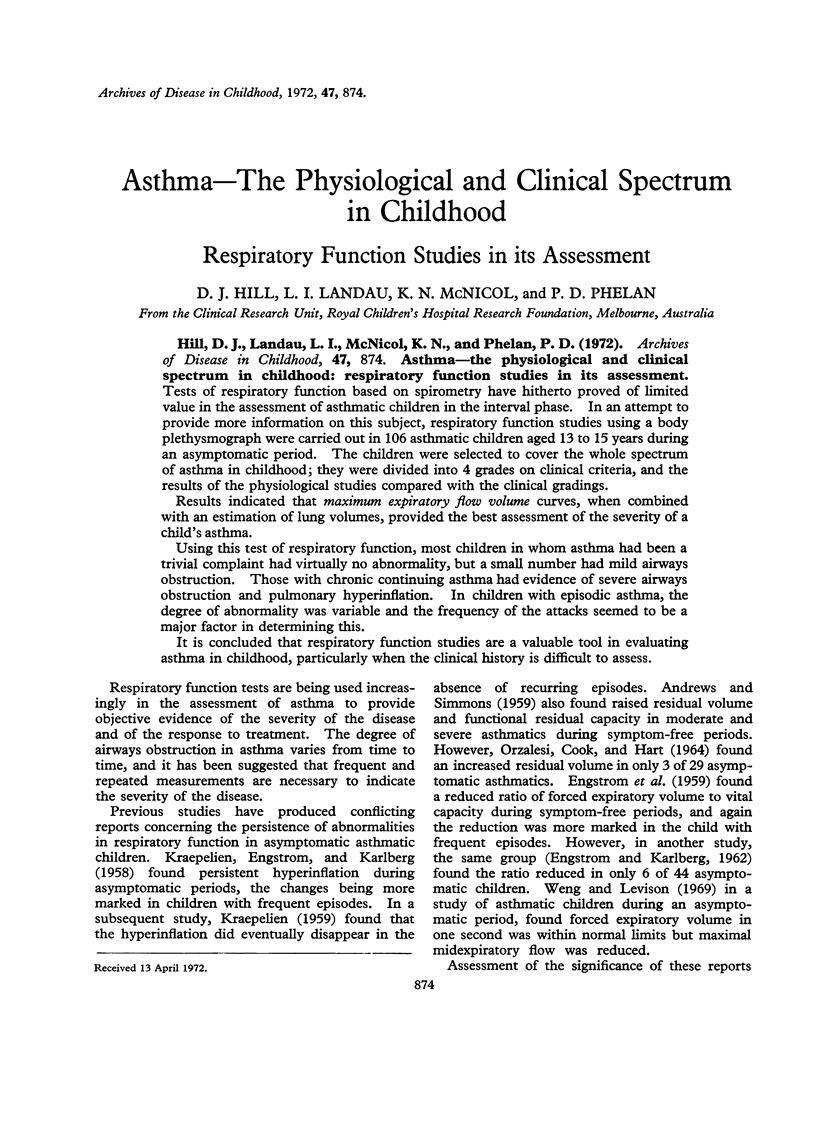
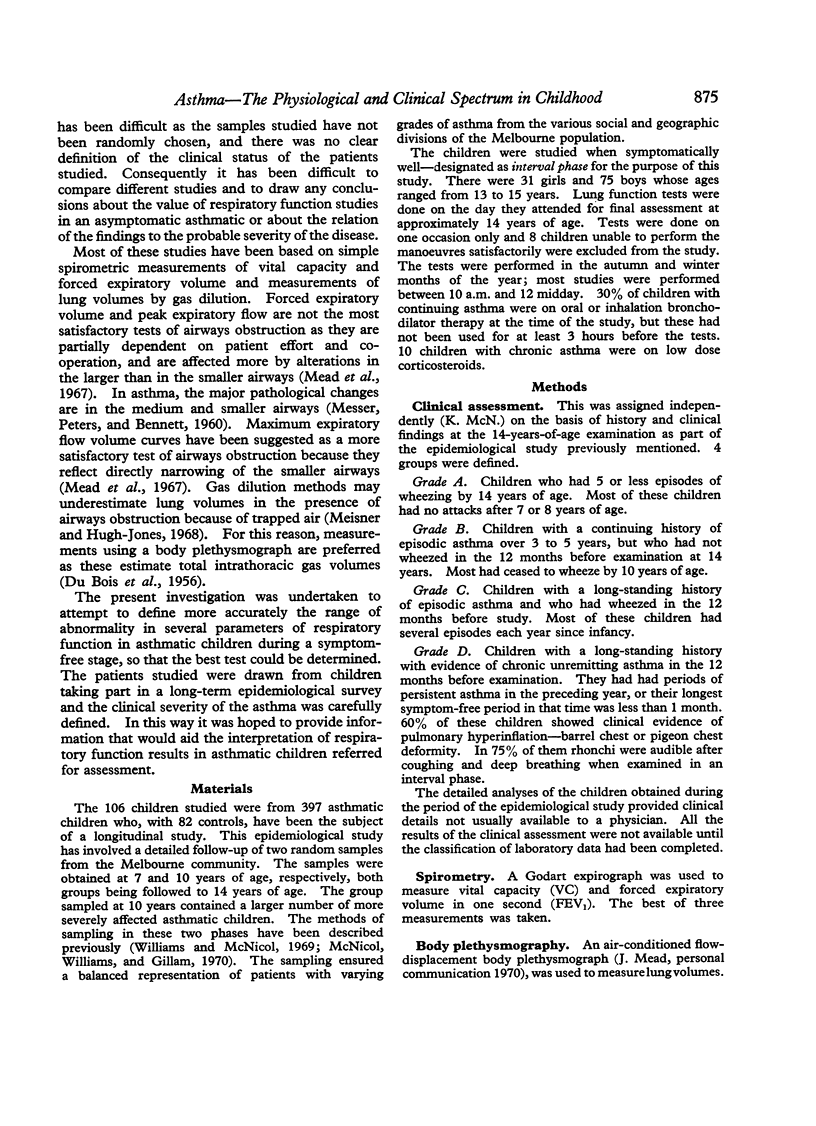
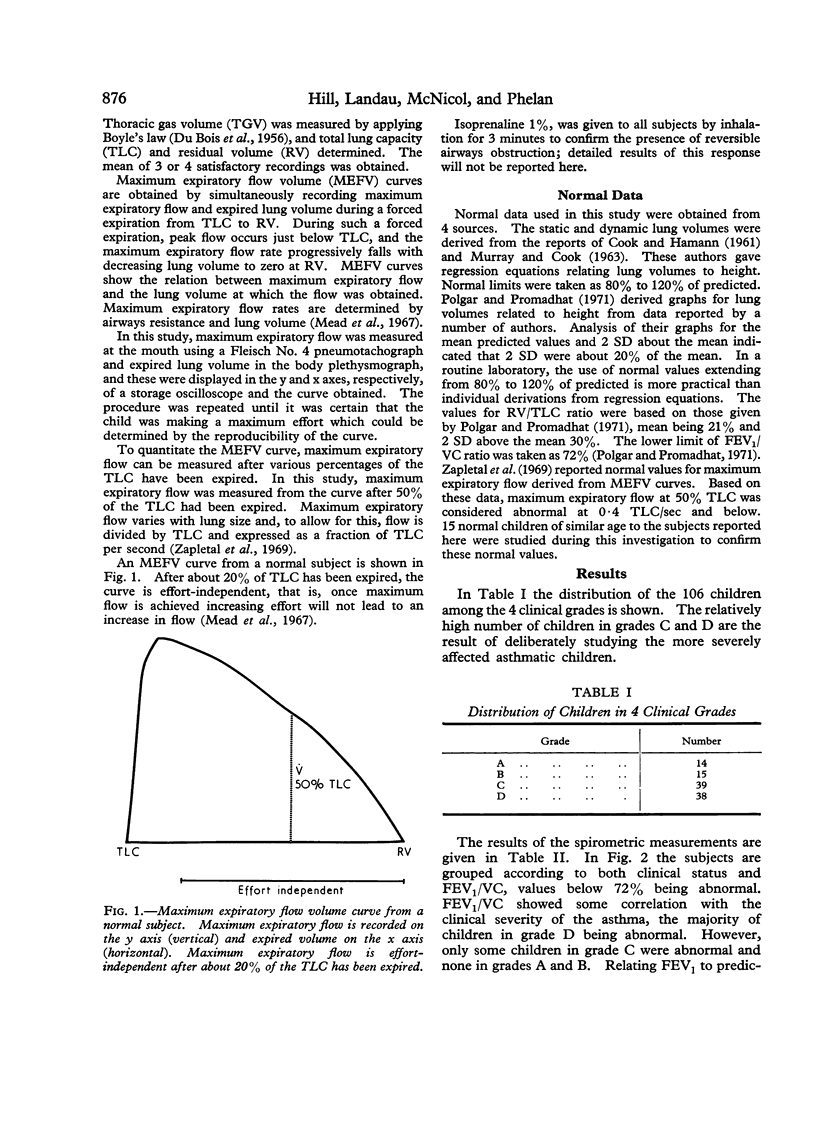


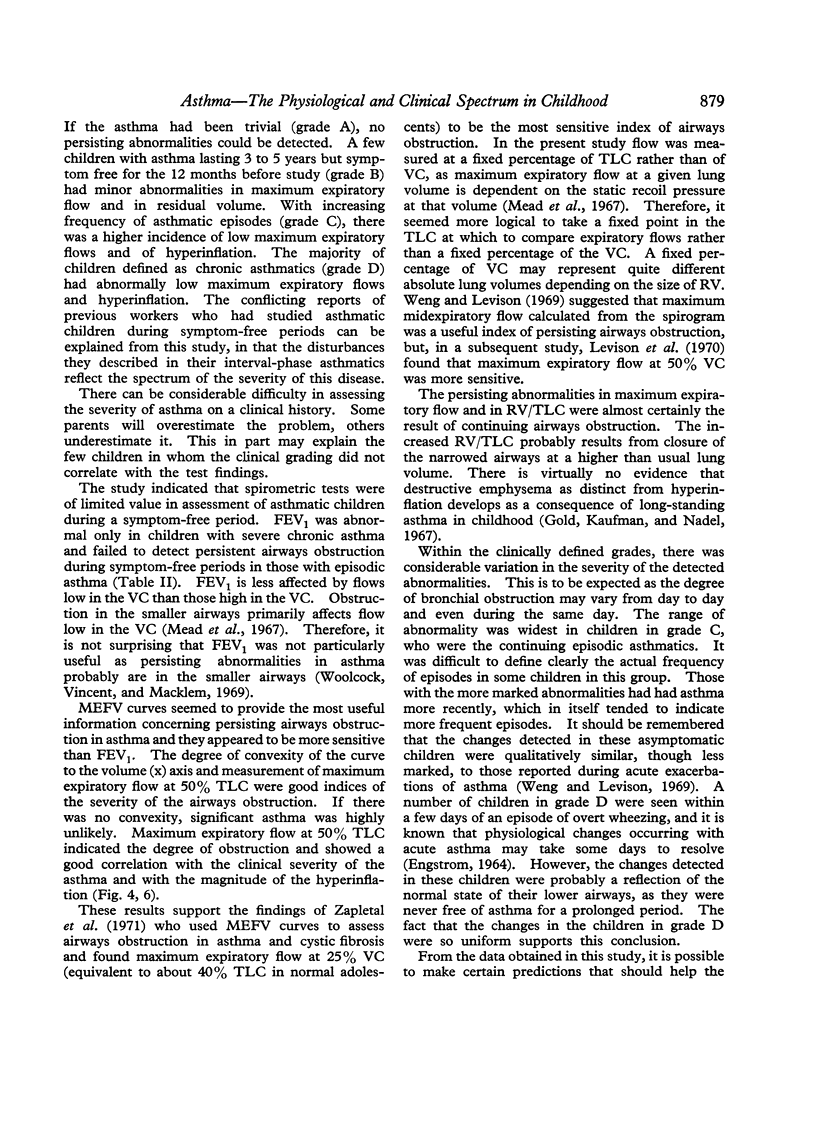
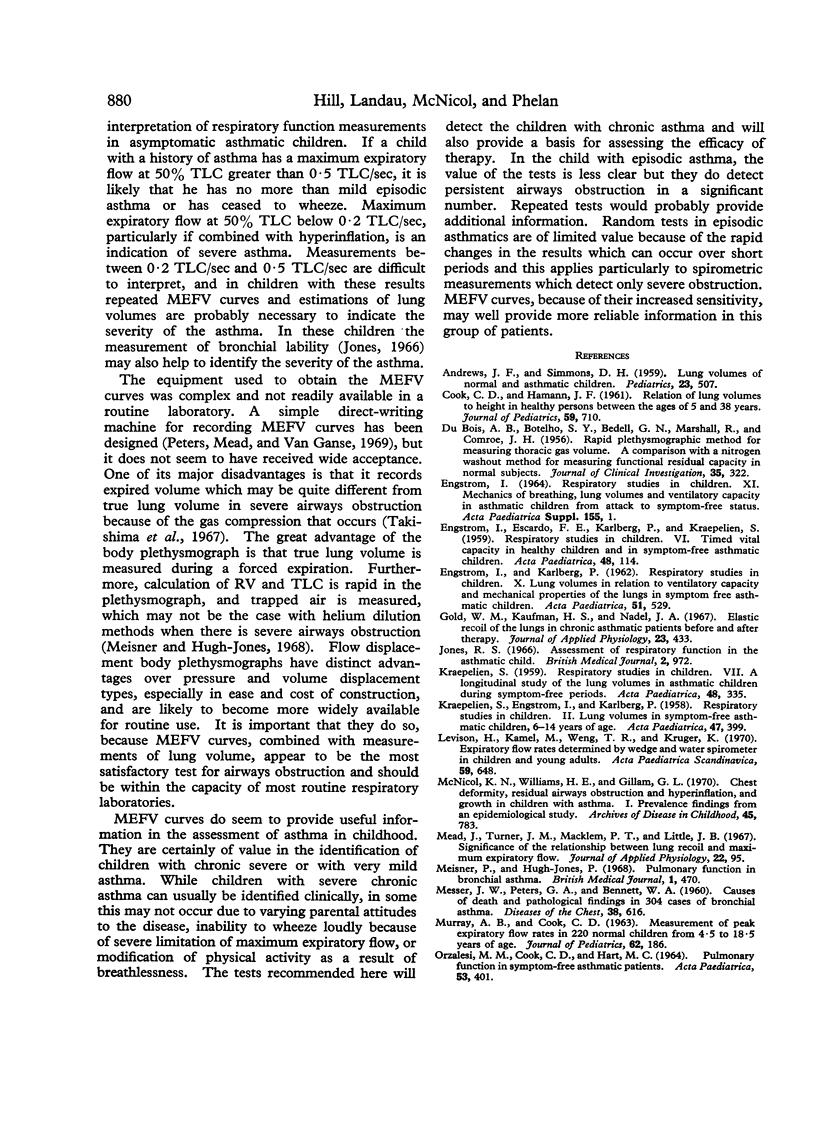
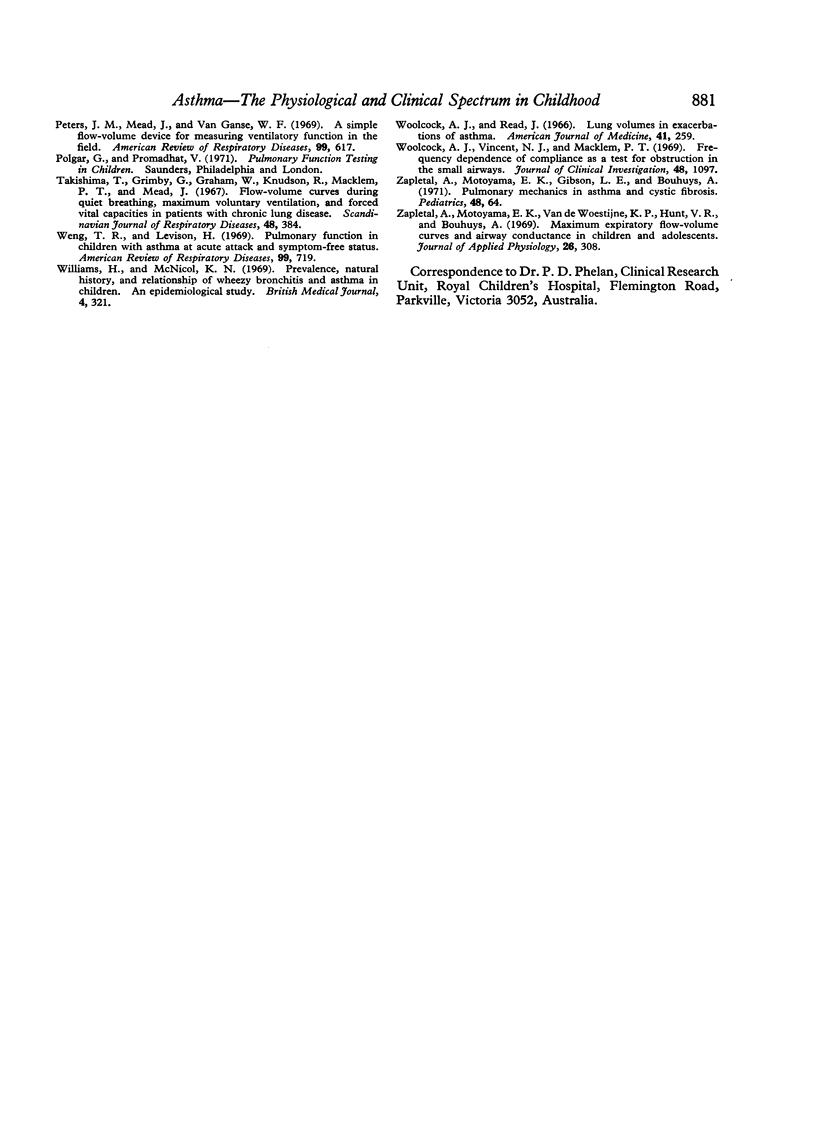
Selected References
These references are in PubMed. This may not be the complete list of references from this article.
- ANDREWES J. F., SIMMONS D. H. Lung volumes of normal and asthmatic children. Pediatrics. 1959 Mar;23(3):507–519. [PubMed] [Google Scholar]
- COOK C. D., HAMANN J. F. Relation of lung volumes to height in healthy persons between the ages of 5 and 38 years. J Pediatr. 1961 Nov;59:710–714. doi: 10.1016/s0022-3476(61)80007-3. [DOI] [PubMed] [Google Scholar]
- DUBOIS A. B., BOTELHO S. Y., BEDELL G. N., MARSHALL R., COMROE J. H., Jr A rapid plethysmographic method for measuring thoracic gas volume: a comparison with a nitrogen washout method for measuring functional residual capacity in normal subjects. J Clin Invest. 1956 Mar;35(3):322–326. doi: 10.1172/JCI103281. [DOI] [PMC free article] [PubMed] [Google Scholar]
- ENGSTROM I., ESCARDO F. E., KARLBERG P., KRAEPELIEN S. Respiratory studies in children. VI. Timed vital capacity in healthy children and in symptom-free asthmatic children. Acta Paediatr. 1959 Mar;48(2):114–120. [PubMed] [Google Scholar]
- Gold W. M., Kaufman H. S., Nadel J. A. Elastic recoil of the lungs in chronic asthmatic patients before and after therapy. J Appl Physiol. 1967 Oct;23(4):433–438. doi: 10.1152/jappl.1967.23.4.433. [DOI] [PubMed] [Google Scholar]
- Jones R. S. Assessment of respiratory function in the asthmatic child. Br Med J. 1966 Oct 22;2(5520):972–975. doi: 10.1136/bmj.2.5520.972. [DOI] [PMC free article] [PubMed] [Google Scholar]
- KRAEPELIEN S., ENGSTROM I., KARLBERG P. Respiratory studies in children. II. Lung volumes in symptom-free asthmatic children, 6-14 years of age. Acta Paediatr. 1958 Jul;47(4):399–411. doi: 10.1111/j.1651-2227.1958.tb07652.x. [DOI] [PubMed] [Google Scholar]
- KRAEPELIEN S. Respiratory studies in children. VII. A longitudinal study of the lung volumes in asthmatic children during symptom-free periods. Acta Paediatr. 1959 Jul;48:335–344. [PubMed] [Google Scholar]
- Levison H., Kamel M., Weng T. R., Kruger K. Expiratory flow rates determined by wedge and water spirometer in children and young adults. Acta Paediatr Scand. 1970 Nov;59(6):648–652. doi: 10.1111/j.1651-2227.1970.tb17699.x. [DOI] [PubMed] [Google Scholar]
- MESSER J. W., PETERS G. A., BENNETT W. A. Causes of death and pathologic findings in 304 cases of bronchial asthma. Dis Chest. 1960 Dec;38:616–624. doi: 10.1378/chest.38.6.616. [DOI] [PubMed] [Google Scholar]
- MURRAY A. B., COOK C. D. Measurement of peak expiratory flow rates in 220 normal children from 4.5 to 18.5 years of age. J Pediatr. 1963 Feb;62:186–189. doi: 10.1016/s0022-3476(63)80390-x. [DOI] [PubMed] [Google Scholar]
- McNicol K. N., Williams H. E., Gillam G. L. Chest deformity, residual airways obstruction and hyperinflation, and growth in children with asthma. I. Prevalence findings from an epidemiological study. Arch Dis Child. 1970 Dec;45(244):783–788. doi: 10.1136/adc.45.244.783. [DOI] [PMC free article] [PubMed] [Google Scholar]
- Mead J., Turner J. M., Macklem P. T., Little J. B. Significance of the relationship between lung recoil and maximum expiratory flow. J Appl Physiol. 1967 Jan;22(1):95–108. doi: 10.1152/jappl.1967.22.1.95. [DOI] [PubMed] [Google Scholar]
- Meisner P., Hugh-Jones P. Pulmonary function in bronchial asthma. Br Med J. 1968 Feb 24;1(5590):470–475. doi: 10.1136/bmj.1.5590.470. [DOI] [PMC free article] [PubMed] [Google Scholar]
- ORZALESI M. M., COOK C. D., HART M. C. PULMONARY FUNCTION IN SYMPTOM-FREE ASTHMATIC PATIENTS. Acta Paediatr. 1964 Sep;53:401–407. doi: 10.1111/j.1651-2227.1964.tb07798.x. [DOI] [PubMed] [Google Scholar]
- Peters J. M., Mead J., Van Ganse W. F. A simple flow-volume device for measuring ventilatory function in the field. Results on workers exposed to low levels of toluene diisocyanate. Am Rev Respir Dis. 1969 Apr;99(4):617–622. doi: 10.1164/arrd.1969.99.4P1.617. [DOI] [PubMed] [Google Scholar]
- Takishima T., Grimby G., Graham W., Knudson R., Macklem P. T., Mead J. Flow-volume curves during quiet breathing, maximum voluntary ventilation, and forced vital capacities in patients with obstructive lung disease. Scand J Respir Dis. 1967;48(3):384–393. [PubMed] [Google Scholar]
- Weng T. R., Levison H. Pulmonary function in children with asthma at acute attack and symptom-free status. Am Rev Respir Dis. 1969 May;99(5):719–728. doi: 10.1164/arrd.1969.99.5.719. [DOI] [PubMed] [Google Scholar]
- Williams H., McNicol K. N. Prevalence, natural history, and relationship of wheezy bronchitis and asthma in children. An epidemiological study. Br Med J. 1969 Nov 8;4(5679):321–325. doi: 10.1136/bmj.4.5679.321. [DOI] [PMC free article] [PubMed] [Google Scholar]
- Woolcock A. J., Read J. Lung volumes in exacerbations of asthma. Am J Med. 1966 Aug;41(2):259–273. doi: 10.1016/0002-9343(66)90021-0. [DOI] [PubMed] [Google Scholar]
- Woolcock A. J., Vincent N. J., Macklem P. T. Frequency dependence of compliance as a test for obstruction in the small airways. J Clin Invest. 1969 Jun;48(6):1097–1106. doi: 10.1172/JCI106066. [DOI] [PMC free article] [PubMed] [Google Scholar]
- Zapletal A., Motoyama E. K., Gibson L. E., Bouhuys A. Pulmonary mechanics in asthma and cystic fibrosis. Pediatrics. 1971 Jul;48(1):64–72. [PubMed] [Google Scholar]
- Zapletal A., Motoyama E. K., Van De Woestijne K. P., Hunt V. R., Bouhuys A. Maximum expiratory flow-volume curves and airway conductance in children and adolescents. J Appl Physiol. 1969 Mar;26(3):308–316. doi: 10.1152/jappl.1969.26.3.308. [DOI] [PubMed] [Google Scholar]


